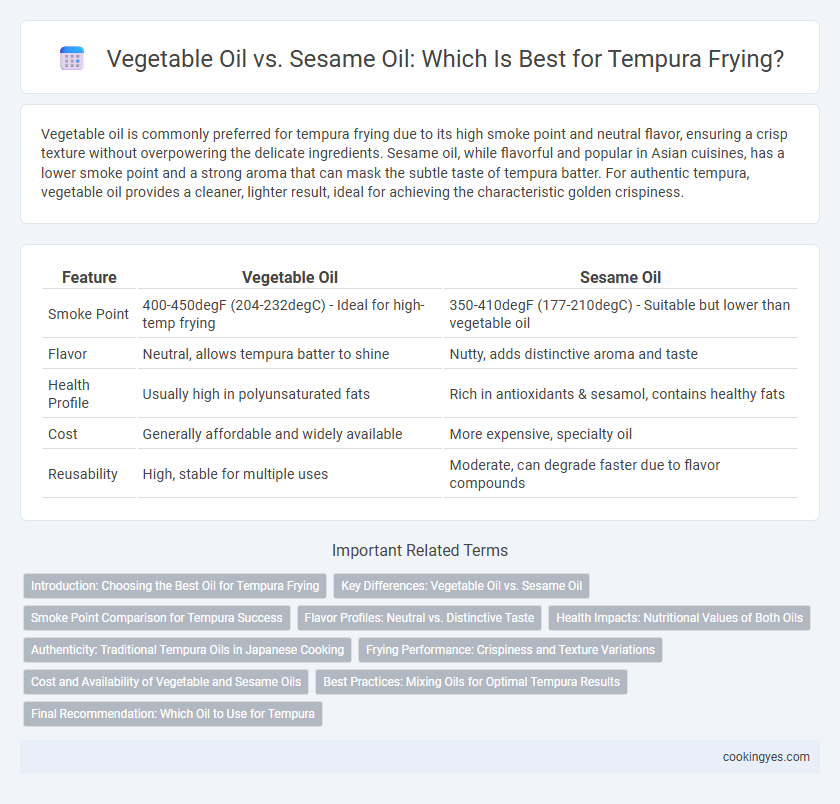Vegetable oil is commonly preferred for tempura frying due to its high smoke point and neutral flavor, ensuring a crisp texture without overpowering the delicate ingredients. Sesame oil, while flavorful and popular in Asian cuisines, has a lower smoke point and a strong aroma that can mask the subtle taste of tempura batter. For authentic tempura, vegetable oil provides a cleaner, lighter result, ideal for achieving the characteristic golden crispiness.
Table of Comparison
| Feature | Vegetable Oil | Sesame Oil |
|---|---|---|
| Smoke Point | 400-450degF (204-232degC) - Ideal for high-temp frying | 350-410degF (177-210degC) - Suitable but lower than vegetable oil |
| Flavor | Neutral, allows tempura batter to shine | Nutty, adds distinctive aroma and taste |
| Health Profile | Usually high in polyunsaturated fats | Rich in antioxidants & sesamol, contains healthy fats |
| Cost | Generally affordable and widely available | More expensive, specialty oil |
| Reusability | High, stable for multiple uses | Moderate, can degrade faster due to flavor compounds |
Introduction: Choosing the Best Oil for Tempura Frying
Vegetable oil and sesame oil vary significantly in smoke points and flavor profiles, influencing their suitability for tempura frying. Vegetable oil, with its high smoke point around 400degF (204degC), ensures a crisp, light batter without imparting strong flavors. Sesame oil, especially toasted, has a lower smoke point near 350degF (177degC) and adds a distinct nutty aroma, which can overpower tempura's delicate taste if used excessively.
Key Differences: Vegetable Oil vs. Sesame Oil
Vegetable oil offers a neutral flavor and high smoke point around 400degF, making it ideal for crisp, light tempura frying without overpowering the delicate batter. Sesame oil, particularly toasted sesame oil, has a distinctive nutty aroma and a lower smoke point near 350degF, which can add depth to tempura but risks burning if the temperature is too high. Choosing between vegetable and sesame oil impacts the tempura's flavor profile, frying temperature control, and overall texture.
Smoke Point Comparison for Tempura Success
Vegetable oil typically has a smoke point ranging from 400degF to 450degF, making it ideal for maintaining the high heat required for perfectly crispy tempura without burning. Sesame oil, especially unrefined, has a lower smoke point around 337degF, which can cause the oil to burn quickly and impart a strong flavor that may overpower the delicate tempura batter. Using vegetable oil ensures a cleaner frying process, preserving the light texture and authentic taste essential to tempura.
Flavor Profiles: Neutral vs. Distinctive Taste
Vegetable oil provides a neutral flavor that allows the natural taste of tempura ingredients to shine without overpowering them. Sesame oil offers a distinctive, nutty aroma and rich taste that can enhance the tempura but may alter the traditional flavor profile. Choosing between vegetable and sesame oil depends on whether a subtle or more pronounced flavor experience is desired in tempura frying.
Health Impacts: Nutritional Values of Both Oils
Vegetable oil, typically rich in polyunsaturated fats and vitamin E, supports heart health but may contain omega-6 fatty acids that in excess can promote inflammation. Sesame oil offers a unique blend of antioxidants like sesamol and sesamin, along with monounsaturated fats that help reduce oxidative stress and improve cholesterol levels. Choosing sesame oil for tempura frying enhances the dish's nutritional profile by providing better stability at high heat and additional health benefits compared to standard vegetable oils.
Authenticity: Traditional Tempura Oils in Japanese Cooking
Traditional tempura frying in Japanese cooking primarily uses vegetable oils like canola or soybean oil due to their neutral flavor and high smoke point, which preserves the delicate texture of tempura. Sesame oil, while aromatic and flavorful, is less common in authentic tempura recipes as its strong taste can overpower the subtle flavors of fresh seafood and vegetables. Using neutral vegetable oils ensures the genuine lightness and crispness characteristic of traditional tempura dishes.
Frying Performance: Crispiness and Texture Variations
Vegetable oil provides a neutral flavor and high smoke point, producing a light and crispy tempura with an even, delicate texture ideal for showcasing the ingredients. Sesame oil, especially toasted variety, imparts a distinct nutty aroma and richer taste but may result in a slightly heavier batter with less pronounced crispiness due to its lower smoke point. For optimal frying performance, vegetable oil is preferred for maintaining tempura's signature crisp texture, while sesame oil adds flavor complexity at the expense of traditional lightness.
Cost and Availability of Vegetable and Sesame Oils
Vegetable oil is generally more cost-effective and widely available than sesame oil, making it a preferred choice for tempura frying in commercial kitchens. Sesame oil, while offering a distinct flavor, tends to be more expensive and less accessible, especially in large quantities. The affordability and easy procurement of vegetable oil contribute to its popularity for achieving the light, crisp texture essential in authentic tempura.
Best Practices: Mixing Oils for Optimal Tempura Results
Using a blend of vegetable oil and sesame oil for tempura frying enhances flavor and improves crispiness by combining the high smoke point of vegetable oil with the aromatic qualities of sesame oil. A common best practice is to mix 80% vegetable oil with 20% toasted sesame oil, which maintains frying temperature stability while imparting a subtle nutty taste. This balance prevents oil overheating and ensures a light, crispy tempura texture without compromising flavor integrity.
Final Recommendation: Which Oil to Use for Tempura
Vegetable oil offers a neutral flavor and high smoke point, making it ideal for achieving the classic light, crispy texture of tempura without overpowering the dish. Sesame oil imparts a distinctive nutty aroma but has a lower smoke point, which may result in a heavier, slightly oily finish if used alone. For optimal tempura frying, blending vegetable oil with a small amount of toasted sesame oil balances crispiness and flavor, preserving authenticity while enhancing taste.
Vegetable oil vs sesame oil for tempura frying Infographic

 cookingyes.com
cookingyes.com